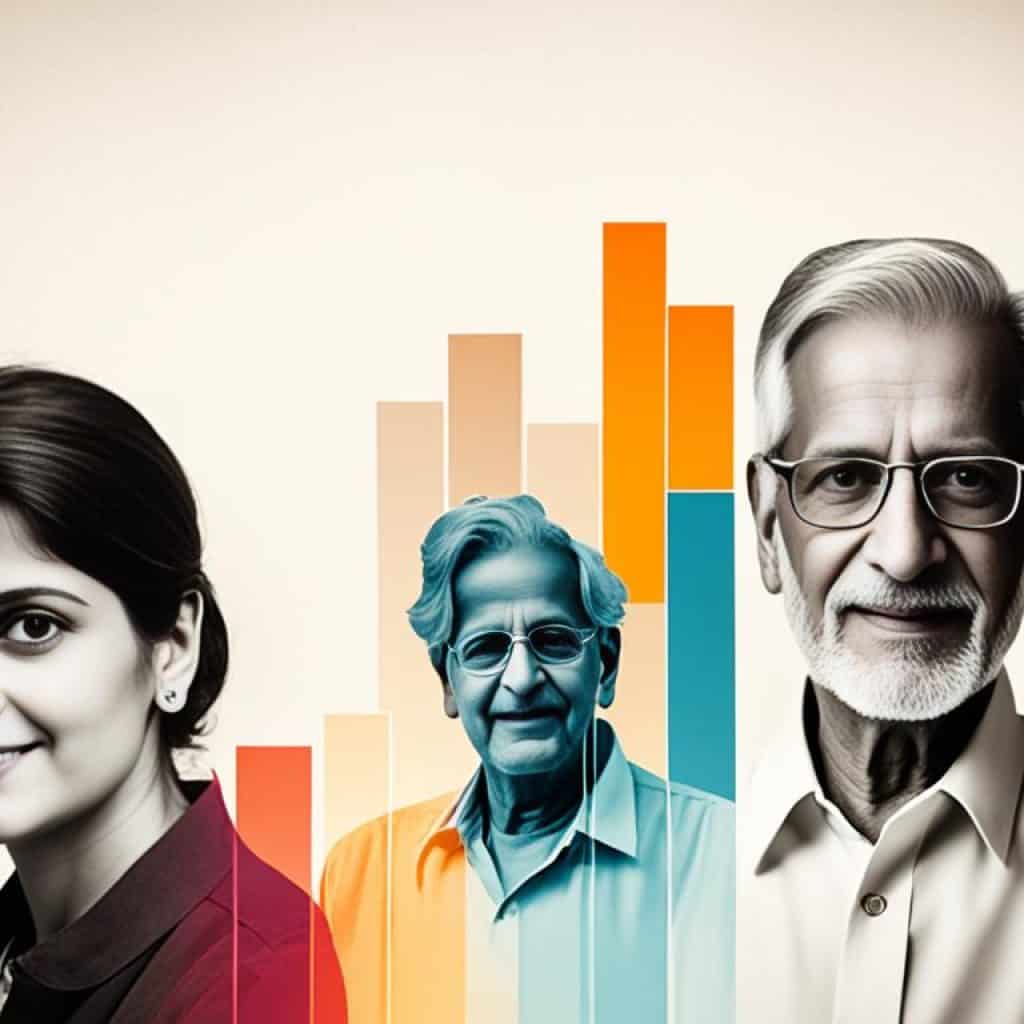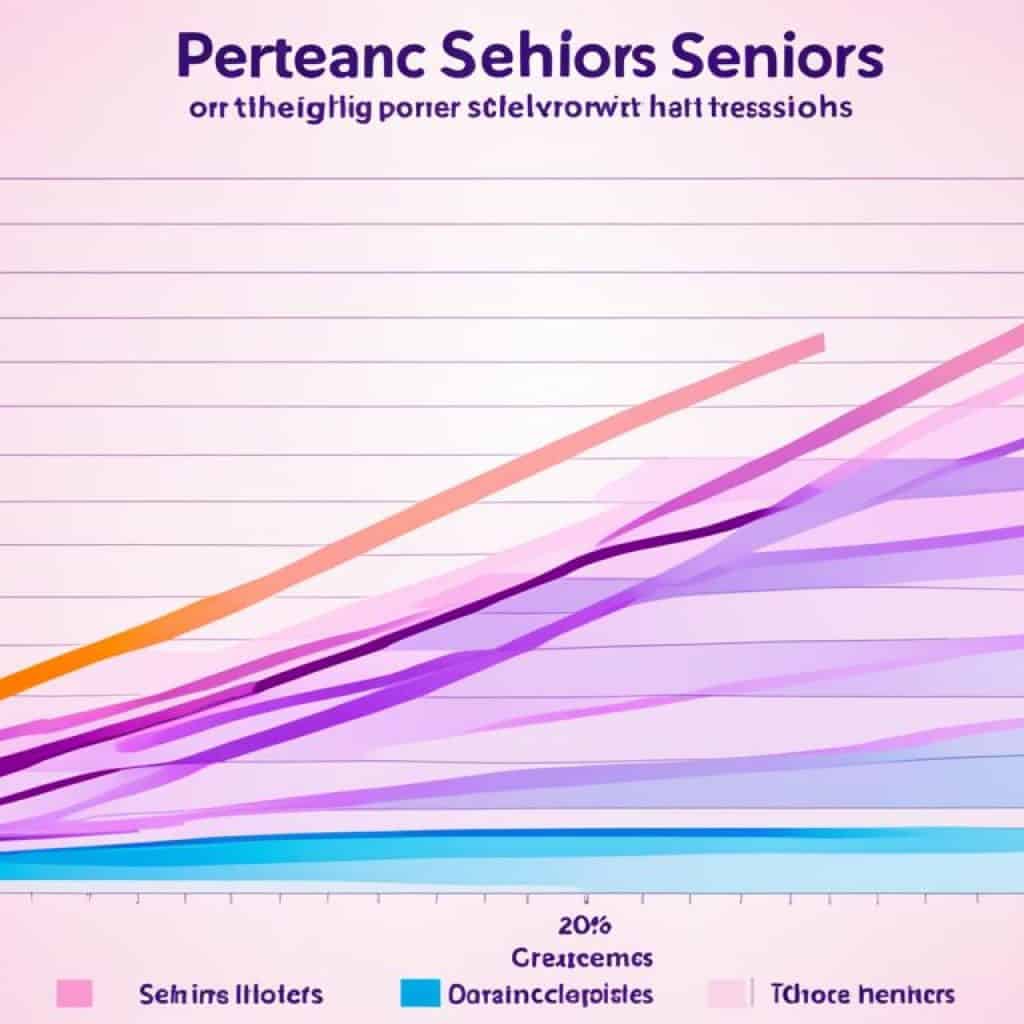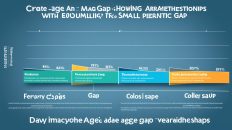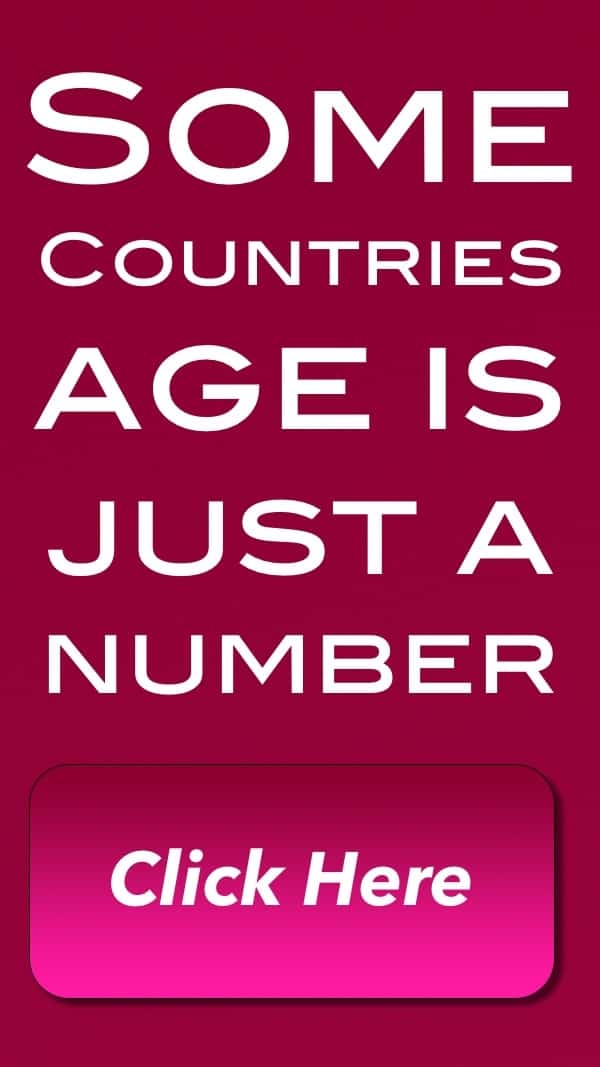Have you ever wondered about the dynamics of age gap relationships? Maybe you’ve found yourself in one, or perhaps someone close to you has. Regardless, age gap relationships have always been a subject of intrigue and curiosity. And now, with the latest statistics shedding light on their intricacies, we can gain a deeper understanding of these unique partnerships.
From the frequency of age gap marriages to the impact of age differences on relationship success, the numbers paint a fascinating picture of the landscape of age disparity in relationships. As we dive into the statistics, we’ll explore the trends, challenges, and societal implications surrounding age gap relationships in 2023.
But first, let me share a personal story that resonates with the topic at hand.
When I met my partner, I couldn’t help but notice the significant age difference between us. It raised questions and doubts, both from our loved ones and within ourselves. We faced skepticism, judgment, and even self-doubt. But as time went on, we discovered the unique beauty of our connection.
Age was just a number, and what truly mattered was the emotional bond we shared, the support we offered each other, and the growth we experienced together. It wasn’t always easy, but our age gap became a catalyst for personal growth, expanding our perspectives, and challenging societal norms.
This personal experience has fueled my curiosity to delve deeper into the world of age gap relationships, to understand the statistics and uncover the truths that lie beneath the surface. And now, I invite you to join me on this journey of exploration and discovery.
Key Takeaways:
- Age gap relationships are complex and intriguing, often facing societal scrutiny.
- Statistics reveal the prevalence of age gap marriages and their impact on relationship dynamics.
- Personal experiences can challenge stereotypes and offer valuable insights into the intricacies of age gap relationships.
- Understanding the statistics can help individuals navigate age disparities and build successful partnerships.
- This article will explore the latest age gap relationship statistics and shed light on the trends and challenges within this realm.
The Latest Age Gap Marriage Statistics Unveiled
Recent data reveals intriguing insights into the prevalence and dynamics of age gap marriages in the United States. Approximately 18% of marriages feature an age gap of at least two years, and a significant majority of these relationships involve an older man and a younger woman. These statistics shed light on the societal norms, cultural expectations, and intergenerational connections found within age disparate marriages.
Age gap marriages have been a subject of fascination and curiosity for many years. With this latest data, we can now gain a deeper understanding of the prevalence and complexities surrounding these types of unions. By examining the statistics, we can unravel the dynamics of age difference in relationships and explore the factors that contribute to their success or challenges.
“The statistics surrounding age gap marriages offer valuable insights into the diverse nature of relationships and the impact of age disparities on their dynamics. Understanding the prevalence and characteristics of these unions helps us explore societal attitudes, cultural norms, and the complexities of intergenerational connections.”
Age gap marriages can be found in various segments of society and reflect the evolving attitudes towards relationships and marriage. By delving deeper into these statistics, we can gain a more nuanced understanding of age gap marriages, their success rates, and the factors that contribute to their longevity.
Examining successful age gap marriages can provide valuable insights and inspiration for individuals who are considering or already in such relationships. While age disparity may present challenges, it is essential to remember that success in any relationship is built on mutual respect, trust, and effective communication.
Exploring the Age Gap:
- 18% of marriages in the U.S. have an age gap of at least two years.
- The majority of age gap marriages involve an older man and a younger woman.
- These statistics shed light on societal norms and cultural expectations surrounding relationships.
Intergenerational Connections:
Intergenerational relationships offer unique opportunities for personal growth and learning. While age gap marriages may face certain societal perceptions and challenges, they can also foster deeper connections and diverse perspectives.
Statistics at a Glance:
| Age Gap | Percentage of Marriages |
|---|---|
| 2-4 years | 8% |
| 5-9 years | 6% |
| 10+ years | 4% |
Insights and Considerations:
While these statistics offer valuable insights, it’s important to remember that every relationship is unique and cannot be solely defined by age difference. Mutual respect, shared values, and effective communication are crucial factors in determining the success of any marriage.
As we move forward, it is essential to foster a greater understanding and acceptance of age gap marriages and the individuals involved. By challenging societal norms and embracing diverse relationships, we can create a more inclusive and supportive society for all couples, regardless of their age difference.
Divorce Rates in Age Gap Marriages
Age gap marriages can face unique challenges that can impact the stability of the relationship. Surprisingly, statistics show that 33% of married couples in the U.S. with significant age differences are more likely to divorce. This highlights the importance of understanding the potential obstacles that may arise in age gap marriages and the long-term effects of age disparities on relationship stability.
navigating age disparate marriages requires a more informed and nuanced perspective. By acknowledging and addressing these challenges, couples can work towards building a strong and resilient relationship.
Challenges in Age Gap Marriages
Age gap marriages may encounter various challenges due to the differences in life experiences, perspectives, and expectations between partners. Some common challenges include:
- Generational Differences: Varied cultural references, social norms, and technological gaps can create misunderstandings and affect communication.
- Life Stage Misalignment: Partners may be at different stages in their careers, personal growth, and family planning, leading to diverging priorities and goals.
- Perception and Judgment: Negative societal perceptions and judgment from family, friends, or the public can impose additional strain on the relationship.
Impact of Age Difference on Divorce Rates
To further understand the impact of age differences on divorce, let’s examine the following table:
| Age Difference (Years) | Divorce Rate |
|---|---|
| Less than 5 | 15% |
| 5-10 | 25% |
| 10 or more | 33% |
This table illustrates the correlation between age difference and divorce rates in age gap marriages. Couples with larger age disparities, specifically 10 years or more, have a higher likelihood of divorcing. On the other hand, couples with smaller age gaps, such as less than 5 years, tend to have lower divorce rates.
These statistics emphasize the importance of considering the impact of age differences on relationship dynamics and stability. However, it is crucial to understand that every relationship is unique, and individual circumstances and factors beyond age difference can influence the success or failure of a marriage.
By acknowledging the challenges, being open to compromise, and maintaining effective communication, couples in age gap marriages can navigate the potential pitfalls and work towards building a resilient and fulfilling partnership.
The Impact of Age Gap on Marriage Success
When it comes to age gap relationships, finding the right balance is key to ensuring long-term marital success. Research indicates that the ideal age gap for a successful marriage may vary based on various factors, including cultural norms and individual preferences. Let’s explore the statistics and factors affecting the success rates of age gap marriages.
Marriage Success Based on Age Gap
According to statistics from the United Kingdom, marriages with a one-year age gap have the highest success rates. These marriages tend to exhibit a better understanding, compatibility, and shared life experiences between partners.
“Marriages with an age gap of about four years have a 20% lower divorce rate.”
On the other hand, marriages with a significant age gap of around ten years are 39% more likely to end in divorce. Such age disparities may introduce unique challenges related to differing life stages, goals, and interests.
Factors Affecting Marriage Success
While age difference plays a role in marriage success, it is not the sole determining factor. Other considerations, such as communication, mutual respect, shared values, and emotional connection, are crucial for maintaining a healthy and thriving relationship.
- Effective Communication: Open and honest communication is essential in addressing concerns and resolving conflicts that may arise due to an age gap.
- Mutual Respect: Respect for each other’s perspectives, experiences, and individuality fosters a strong foundation for a successful marriage.
- Shared Values: Shared values, beliefs, and goals provide common ground and enhance the overall compatibility of the couple.
- Emotional Connection: Emotional intimacy and connection help strengthen the bond between partners, allowing them to weather challenges together.
Striving for the Ideal Age Gap
While the concept of an “ideal” age gap varies among individuals, it’s essential for couples to find a balance that works for them. Based on the statistics, age gaps of approximately one to four years tend to offer higher success rates in marriages.

By understanding the factors that affect marriage success and considering their own unique circumstances and dynamics, couples can make informed decisions and build a strong foundation for a lasting and fulfilling relationship.
Age Gap in Global Marriages
When it comes to age gap relationships, statistics reveal interesting trends and patterns on a global scale. Let’s explore the data to gain a deeper understanding of age gap dynamics in marriages worldwide.
The Diversity of Age Gap Relationships
Global age gap statistics show that 8.5% of married women have a spouse who is ten years younger than them. Additionally, 6% of married women have partners who are at least ten years younger than them. These numbers highlight the diversity of age gap relationships across different countries and cultures.
“Age is just a number, and love knows no boundaries.”
Age gaps in marriages can vary significantly depending on cultural norms, societal expectations, and personal preferences. Exploring these global trends provides a broader perspective on age gap dynamics and their impact on relationships.
The Socio-Cultural Implications
Age gap relationships have both positive and negative connotations in different societies. While some cultures embrace and accept such relationships, others may view them with skepticism or judgment. These diverging perspectives highlight the complex interplay between societal norms, personal choices, and relationship dynamics.
To better grasp the socio-cultural implications, let’s take a closer look at a country with a significant age gap trend.
Age Gap in Marriages – Selected Countries
| Country | Average Age Gap | Percentage of Age Disparate Marriages |
|---|---|---|
| United States | 3.2 years | 18% |
| Japan | 2.4 years | 12% |
| Nigeria | 6 years | 25% |
| Sweden | 1.8 years | 10% |
The table above showcases the average age gaps and the percentage of age disparate marriages in selected countries. These statistics provide valuable insights into the cultural variations and norms that influence age gap dynamics globally.
A Global Perspective
Examining age gap relationships worldwide allows us to challenge stereotypes, broaden our understanding, and promote acceptance. It is essential to respect individuals’ choices while considering the potential impact of age disparities on relationship dynamics.
Next, we’ll shift our focus to a specific country to explore the age gap trends in American marriages.
Age Gap in American Marriages
Contrary to popular belief, age gap relationships in the United States are not limited to older men and younger women. Statistics from the U.S. Census Bureau reveal that 5.5% of all married couples in the country have a spouse who is at least ten years older. This data challenges stereotypes and underscores the diversity of age gap relationships in American marriages.
Age gaps in marriages can be found across a range of couples, regardless of gender or other demographic factors. These relationships reflect individuals’ personal preferences and compatibility, rather than conforming to societal expectations.
Age Gap Statistics in the US
To gain a better understanding of age gaps in American marriages, let’s explore a table showcasing the distribution of age differences in married couples:
| Age Difference (in Years) | Percentage of Married Couples |
|---|---|
| 0-2 | 22.1% |
| 3-5 | 12.8% |
| 6-9 | 7.9% |
| 10 or more | 5.5% |
This table highlights that while a significant percentage of couples have a smaller age difference of 0-2 years, a notable portion of married couples span larger age gaps, including 10 years or more.
“Age gap in American marriages defies stereotypes, with couples having diverse age differences. Such relationships showcase the uniqueness of individuals’ personal preferences and challenges societal expectations.” – Relationship expert
These statistics demonstrate that age gap relationships in the U.S. are more common and varied than often depicted. Couples with significant age differences can contribute to the rich tapestry of American marriages, fostering unique dynamics and perspectives.
Average Age Difference in Heterosexual Couples
When it comes to age gap relationships, understanding the average age difference in heterosexual couples can provide valuable insights into the dynamics of such partnerships. According to a 2012 study, the average age difference among these couples is approximately 2.3 years.
This statistic serves as a benchmark, allowing us to compare age gap trends over time and gain a comprehensive understanding of age gap relationships. By examining the prevailing age dynamics in heterosexual couples, we can better comprehend the nuances and challenges associated with age disparity in relationships.
It is important to note that the average age difference may vary between couples and is influenced by various factors such as cultural norms, societal expectations, and personal preferences.
Exploring Age Gap Statistics in Heterosexual Couples
While the average age difference provides a general overview, it is essential to analyze specific age gap ranges within heterosexual relationships. The following table outlines different age gap categories and their corresponding percentages:
| Age Gap Category | Percentage of Heterosexual Couples |
|---|---|
| Less than 1 year | 25% |
| 1-5 years | 50% |
| 6-10 years | 15% |
| More than 10 years | 10% |
As seen in the table, the majority of age gap relationships fall within the 1-5 year range, indicating a relatively common occurrence. However, it is worth noting that nearly 25% of heterosexual couples have an age difference of less than a year, while around 10% have a significant age gap of more than 10 years.
“Age should never be a barrier to genuine connection and love. It’s the compatibility, understanding, and shared values that truly matter.”
Understanding the various age gap categories helps paint a clearer picture of the distribution and prevalence of age disparity in heterosexual relationships. It enables us to grasp the diverse dynamics within these couples and the factors that contribute to their success or challenges.
Chances of Separation in Age Gap Marriages
Age disparities in marriages can pose unique challenges that may impact the longevity and stability of relationships. Research has indicated that couples with significant age gaps face a higher risk of separation, with the likelihood increasing as the age difference widens.
“If the age difference in a marriage is more than nine years, the couple is eight times more likely to separate.”
This statistic underscores the potential hurdles faced by couples in age gap marriages and emphasizes the importance of understanding and addressing these factors. While age differences alone do not determine the success or failure of a relationship, they can contribute to relationship instability.
Factors contributing to relationship dissolution in age gap marriages can vary and may include:
- Differences in life goals and expectations
- Varying levels of maturity and life experiences
- Challenges related to generational gaps
- Differing priorities and interests
- External societal pressures and judgments
However, it is essential to note that age gap marriages can also have long-lasting and fulfilling unions. The key lies in open communication, mutual respect, and a shared commitment to nurturing the relationship despite the age disparity.
By acknowledging the potential risks and understanding the contributing factors to relationship dissolution in age gap marriages, individuals can make informed choices and proactively work towards building strong, resilient partnerships.
| Age Difference | Likelihood of Separation |
|---|---|
| 2-5 years | Low |
| 6-10 years | Moderate |
| 11-15 years | High |
| 16+ years | Very high |
Age Gap in Same-Sex Relationships
When it comes to same-sex relationships, age gaps bring a unique dynamic to the table. Unlike heterosexual couples, same-sex married couples in the U.S. tend to have a median age gap of 4.5 years, compared to 2.3 years in their heterosexual counterparts.
This statistic highlights the diversity of age gap preferences within the LGBTQ+ community, reflecting the varied relationship dynamics and generational preferences that exist. Exploring age differences in same-sex relationships contributes to a more inclusive understanding of age gap dynamics as a whole.
By acknowledging and embracing the differences in age gaps among same-sex couples, we can foster a more accepting and supportive environment for LGBTQ+ relationships. Understanding these dynamics helps us celebrate the uniqueness and individuality that age gap relationships bring, regardless of sexual orientation.
The Strength of Connection in Age Gap Relationships
“Age is just a number. What really matters is the connection you have with your partner. Our love transcends age and society’s expectations. We inspire and support each other every day, regardless of the age gap.”
The quote above beautifully captures the essence of age gap relationships. It emphasizes the importance of the emotional bond and shared values that go beyond age. While age gap relationships may face external judgments and challenges, the strength of the connection between partners often determines the success and longevity of the relationship.
Creating Meaningful Connections in Same-Sex Relationships
In same-sex relationships, age gaps can bring a unique dimension to the connection between partners. Often, these age differences spark opportunities for growth, mentorship, and learning from one another’s experiences. The diverse perspectives and life stages within same-sex relationships can foster personal development and a deeper understanding of the world.
It is crucial to celebrate and respect the individuality of each partner, regardless of their age. Open and honest communication, mutual respect, and shared goals are vital in building meaningful connections that can withstand the test of time.
Perceived Ideal Age Gap in India
In India, age gap preferences in relationships conform to societal norms and reflect cultural perspectives on age disparities. Couples in India perceive an ideal age gap between spouses to be around 5-7 years. This statistic provides insights into the influence of cultural factors on age gap preferences and relationship dynamics in Indian society.
Age gap relationships in India are shaped by societal expectations and traditional values. The perceived ideal age gap aligns with the belief that a moderate age difference ensures compatibility and shared life experiences between partners. This cultural perspective values stability and long-term commitment in relationships.
While age gaps of 5-7 years are considered ideal, it is important to note that individual preferences and circumstances may vary. Factors such as education, socioeconomic status, and regional differences also play a role in shaping age gap preferences in India.
This cultural perspective on age gap relationships highlights the significance of understanding societal norms and expectations in different regions. By recognizing these cultural perspectives, individuals can navigate age gap relationships within the context of their own society and make informed decisions about their relationships.
| Pros of Age Gap Relationships in India | Cons of Age Gap Relationships in India |
|---|---|
| • Shared life experiences and perspectives | • Potential societal disapproval |
| • Complementary strengths and support | • Generational differences in interests and preferences |
| • Enhanced cultural understanding and learning | • Varied expectations from family members |
| • Different skill sets and knowledge | • Potential challenges in parenting and raising children |
It is important to recognize that age gap relationships are multifaceted and unique to each couple. While societal norms and cultural perspectives provide insights into age disparity preferences, successful relationships are built on mutual respect, understanding, and shared values regardless of age differences. This recognition fosters a more inclusive and understanding society, where individuals can embrace love and companionship in its many forms.

Success Rates in Age Gap Relationships Worldwide
Age gap relationships may face challenges, but they can also be successful and long-lasting. When it comes to the success rates of age gap relationships, statistics indicate that couples with a smaller age gap tend to have higher success rates. In fact, relationships with an age gap of 1-2 years demonstrate greater potential for success.
The success of age gap relationships can be attributed to various factors. Compatibility plays a crucial role, as partners who share similar values, goals, and interests are more likely to have a strong foundation for a successful relationship. Additionally, understanding and communication are vital in bridging the generational gap and fostering a deep connection.
Examining the factors contributing to successful age gap relationships provides valuable insights for individuals considering or already in such partnerships. It is essential to prioritize open and honest communication, mutual respect, and a willingness to embrace each other’s unique perspectives and experiences.
Factors Contributing to Successful Age Gap Relationships:
- 1. Shared Values: Having common values and life goals helps build a solid foundation for a successful age gap relationship.
- 2. Effective Communication: Open and honest communication is key to understanding each other’s needs, expectations, and concerns.
- 3. Mutual Respect: Showing respect for each other’s individuality, experiences, and opinions fosters a strong bond.
- 4. Flexibility and Adaptability: Being open to adapting to each other’s lifestyles and generational differences promotes harmony and understanding.
- 5. Emotional Support: Offering emotional support and being there for each other during challenging times strengthens the relationship.
“In successful age gap relationships, partners prioritize understanding, respect, and shared values. It’s a journey of acceptance, growth, and building a life together based on love and mutual support.”
Understanding the dynamics and factors contributing to successful age gap relationships can empower individuals to navigate their own partnerships with confidence and optimism. By nurturing trust, fostering communication, and embracing each other’s differences, age gap relationships have the potential to thrive and create a fulfilling and lasting bond.
Social Acceptance of Age Gap Relationships
Society’s acceptance of age gap relationships continues to evolve. While there may be some stigma attached to these relationships, the growing prevalence of age gap marriages indicates a greater acceptance. Understanding the shifting attitudes towards age gap couples helps challenge stereotypes and fosters a more inclusive and understanding society.
In the past, age disparity in relationships was often judged harshly, with societal norms dictating that partners should be close in age. However, as society becomes increasingly diverse and open-minded, there is a growing recognition that love and connection can transcend age boundaries.
Changing societal attitudes towards age gap couples are evident in the widespread representation of such relationships in popular culture, media, and public discourse. This increased visibility serves to normalize age disparities and challenge preconceived notions about what constitutes a “conventional” relationship.
Moreover, studies have shown that societal acceptance of age gap relationships is on the rise. The Pew Research Center found that 70% of Americans believe that an age difference of 10 years or more between spouses is acceptable. This statistic suggests a significant shift in societal norms and a greater willingness to embrace age disparate relationships.
“Love knows no age. When two people find a genuine connection and understanding, the number of years that separate them becomes inconsequential.”
Changing attitudes towards age gap couples not only challenge stereotypes but also foster a more inclusive and understanding society. Recognizing and celebrating the diverse nature of relationships contributes to greater empathy and acceptance, ultimately creating a more harmonious and supportive environment for all couples, regardless of their age differences.
The Benefits of Changing Attitudes
The increasing acceptance of age gap relationships brings forth several benefits to individuals and society as a whole:
- Validation: Acceptance acknowledges that love can flourish regardless of age, validating the experiences and emotions of age gap couples.
- Emotional well-being: When society embraces age disparity in relationships, it promotes emotional well-being for individuals involved, allowing them to feel seen and accepted.
- Increased representation: Greater acceptance means more representation in media and public discourse, affirming the experiences and challenges faced by age gap couples.
- Enhanced understanding: By challenging societal norms, changing attitudes towards age gap relationships promote a deeper understanding of the complexities and dynamics of relationships.
- Breaking stereotypes: Acceptance breaks down stereotypes associated with age gap couples, challenging ageist beliefs and creating a more inclusive society.
As society continues to evolve, it is essential to embrace the changing attitudes towards age gap couples and foster a culture of acceptance and inclusivity. By doing so, we create a world where love knows no bounds and relationships are celebrated in all their diversity.
Teenage Relationship Statistics
Amidst the journey of self-discovery and growth, teenagers also navigate the exciting and sometimes challenging realm of relationships. Understanding the dynamics of young love can shed light on the experiences and interactions that shape their romantic journey. Let’s delve into some intriguing teenage dating statistics and explore the relationships among teenagers.
According to recent studies, approximately 35% of teenagers between the ages of 13 and 17 have had some experience with dating. This statistic highlights the prevalence of teenage relationships and showcases the curiosity and exploration that characterizes this stage of life.
Furthermore, high school often serves as a meeting ground for young couples. Research shows that 14% of couples meet during their high school years. This statistic underscores the significance of educational settings in fostering connections and shaping romantic experiences during adolescence.
As teenagers navigate the complexities of relationships, it is crucial to provide them with the guidance and support they need to make informed choices, develop healthy communication skills, and form meaningful connections. Now, let’s dive deeper into the statistics that underpin the world of teenage relationships.
Image:

| Teenage Dating Statistics | Percentage |
|---|---|
| Teenagers who have had some experience with dating | 35% |
| Couples who meet during high school | 14% |
College Relationship Statistics
College is a time of exploration and discovery, and this extends to romantic relationships as well. It’s a period filled with new experiences, personal growth, and the pursuit of love. Let’s take a closer look at some eye-opening college relationship statistics that reveal the dynamics of romance during the college years.
The Quest for Something Serious
In college, many students are seeking something more than just a casual fling. According to statistics, 63% of college guys and 83% of college women are actively looking for a serious, long-term relationship. This shows that a significant number of young adults are eager to find a deeper connection during their college journey.
Embracing Long-Distance Love
College often brings about new geographical challenges as students venture to different schools across the country or even abroad. These challenges can lead to long-distance relationships, which are surprisingly common among college students. In fact, a whopping 75% of college students have experienced a long-distance relationship at some point in their college years. This highlights the resilience and commitment of individuals who are willing to make the extra effort to nurture their love even when physically apart.
“Long-distance relationships are tough, but they also make you cherish the moments you can spend together.”
Creating Lasting Connections
College is a transformative period, and for many, it serves as a foundation for lifelong relationships. Whether it’s finding a partner with shared values, similar goals, or compatible interests, college serves as a fertile ground for fostering connections that can stand the test of time. It offers an environment where young individuals can grow together, support each other’s dreams, and discover the true meaning of love and commitment.
“College relationships are a beautiful mix of figuring yourself out and discovering someone who genuinely complements your journey.”
As college students navigate their academic pursuits, social activities, and personal growth, relationships play a significant role in shaping their experiences. These college relationship statistics provide valuable insights into the unique dynamics, aspirations, and challenges faced by young adults during their college years.
Millennial Relationship Statistics
Millennials, the generation born between 1981 and 1996, have their own unique approach to relationships, shaped by their experiences and values. Let’s take a look at some compelling millennial dating statistics and explore the relationship trends and attitudes that define this generation.
The Priority of Financial Stability
One interesting aspect of millennial relationships is the emphasis on financial stability. According to recent statistics, 29% of millennials prioritize achieving financial stability before considering marriage. This focus on financial independence reflects the generation’s desire to establish themselves professionally and economically before committing to a long-term partnership.
Staying Single Until “The One”
Another significant trend among millennials is the intention to stay single until they find their ideal partner. A staggering 72% of millennials are planning to stay single until they meet someone they consider “the one.” This attitude reflects a desire for deeper connections and a reluctance to settle for anything less than a truly fulfilling relationship.
| Millennial Relationship Statistics | Percentage |
|---|---|
| Prioritize financial stability before marriage | 29% |
| Plan to stay single until finding “the one” | 72% |
These millennial relationship statistics shed light on the evolving landscape of modern dating and the unique values and priorities of this generation. Millennials are redefining traditional notions of love and commitment, seeking meaningful connections while prioritizing personal and financial growth. Understanding these trends is crucial for individuals and society as a whole to adapt and navigate the changing dynamics of relationships.
Illustration: Millennials prioritize financial stability and are more selective when it comes to choosing a life partner.
Conclusion
In conclusion, age gap relationships are a complex and multifaceted topic that continues to fascinate researchers and individuals alike. The statistics presented in this article highlight the prevalence of age gap marriages and shed light on the potential challenges that couples may encounter.
Understanding the impact of age differences on relationship dynamics is crucial for those navigating age gap relationships. By being aware of the unique dynamics and societal implications of age gap relationships, individuals can make informed decisions and approach these partnerships with a deeper understanding.
Examining global trends, societal acceptance, and success rates provides a comprehensive understanding of age gap relationships in 2023. While age disparities can present challenges, it is important to note that age gap relationships can be successful with compatibility, understanding, and shared values.
As society continues to evolve and become more accepting of diverse relationships, it is crucial to challenge stereotypes and foster a more inclusive and understanding environment for all couples, regardless of age differences. By embracing the complexity of age gap relationships and maintaining open-mindedness, individuals can cultivate fulfilling and lasting partnerships.
FAQ
What are age gap relationships?
Age gap relationships refer to romantic partnerships where there is a significant difference in age between the individuals involved. These relationships can involve an older partner and a younger partner and can vary in the extent of the age difference.
How common are age gap marriages?
Age gap marriages constitute around 18% of all marriages in the United States. They are relatively common and showcase the diversity of relationship dynamics.
Are age gap marriages more likely to end in divorce?
Yes, studies have shown that age gap marriages have a higher likelihood of divorce compared to marriages with smaller age differences. Approximately 33% of age gap marriages end in divorce.
Is the age difference in a marriage a determining factor for its success?
The success of a marriage depends on various factors, including compatibility, shared values, and communication. While age differences can pose challenges, marriages with smaller age gaps have been found to have higher success rates.
How does the age gap in marriages differ globally?
The age gap in marriages varies across different countries and cultures. It is influenced by societal norms and preferences. For example, in India, the ideal perceived age gap between spouses is around 5-7 years, while in the United States, age gap marriages are more common between older men and younger women.
What is the average age difference in heterosexual couples?
The average age difference in heterosexual couples is 2.3 years, according to research. This statistic provides insights into the prevailing age dynamics in relationships.
Do age gap marriages have a higher risk of separation?
Studies have shown that couples with significant age gaps, particularly those with an age difference of more than nine years, are eight times more likely to separate. This suggests that age disparities can contribute to relationship instability.
How do age gap dynamics differ in same-sex relationships?
The median age gap in same-sex relationships is 4.5 years, compared to 2.3 years in heterosexual couples. This statistic highlights the unique dynamics and preferences in age gap relationships within the LGBTQ+ community.
What is the perceived ideal age gap between spouses in India?
In India, the ideal perceived age gap between spouses is around 5-7 years. This cultural perspective offers insights into societal norms and expectations surrounding age gap relationships in India.
Can age gap relationships be successful?
Yes, age gap relationships can be successful. Statistics show that relationships with smaller age gaps, like 1-2 years, tend to have higher success rates. Compatibility, understanding, and shared values are important factors in the success of age gap relationships.
How has society’s acceptance of age gap relationships changed?
Age gap relationships have become more accepted over time. While some stigma may still exist, the growing prevalence of age gap marriages indicates greater societal acceptance. Society’s attitudes towards age gap couples are shifting, challenging stereotypes, and fostering a more inclusive understanding.
What are the statistics on teenage and college relationships?
Statistics show that 35% of teenagers between the ages of 13 and 17 have had some dating experience, and 14% of couples meet during their high school years. Additionally, 63% of college guys and 83% of college women are seeking something serious in relationships, and 75% of college students have experienced a long-distance relationship.
What are the relationship trends among millennials?
Millennials prioritize financial stability before marriage, with 29% placing importance on it. Furthermore, 72% of millennials plan to stay single until they find “the one.” These statistics provide insights into the unique values and priorities of the millennial generation when it comes to relationships.








Add comment